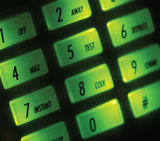
Command and Control
Web-based communications are revolutionizing remote programming, monitoring
- By Andy Johannsen
- Jun 01, 2009
Although Web-based technology is new to fire communications, it was just what
the St. Andrews School in Delaware needed. John Menter of Sentinel Service
was tasked with updating an antiquated alarm system with a new addressable
solution that would include fire protection for eight separate buildings and control future
budget and maintenance costs.
Today, in the field of fire detection, new technology has been specifically developed
for use with the Internet. This technology brings fire alarm communications into the
21st century and provides far more details than existing systems. These new solutions
have the power to address demanding applications, such as in retail outlets, restaurants,
shopping malls, airports, high-rise buildings, healthcare facilities and schools.
Remote Troubleshooting
Using real-time, on-screen overviews of system information is a value that is immediately
evident to fire marshals, end users and service providers. A virtual display of
the control panel from any onsite computer and Web browser is ideal for diagnosing
problems since it gives users the ability to access the system as if they were in front of
the panel. This means users can evaluate situations that may require an immediate or a
scheduled response from any PC with a Web browser and panel/LAN connection. In a
world of immediate information access, this provides that critical capability from any
onsite location.
Remote access also can be of great benefit to building managers, as well as service
personnel. With Web-based technology, building managers can remotely view system
information, leading to informed decision making, better onsite maintenance and lowered
costs. Service technicians also can control costs by remotely evaluating panel
information and planning the response instead of dispatching a technician to the site.
An example of such cost savings occurred at the St. Andrews School.
"The school went live with the system last summer," Menter said. "Then one night,
a smoke detector sounded. Using my home computer and eSP Discovery, I determined
that the trouble was a smoke head that was slightly out of sensitivity. Instead of sending
a technician for an emergency service call, we dispatched one the next day. This saved
me manpower time and saved the customer a significant emergency service bill."
With these new systems, capability is scalable, ranging from stand-alone singlepanel
systems with up to 800 devices to a fully supervised, fault-tolerant multipanel
networked system with more than 100,000 points and 500 zones. Nodes are networked
as one system so central station information can be detailed for the entire network
down to the subpoint level while using a single DACT.
System Software
Web-based software represents a major departure from industry norms. The technological
prowess of these systems translates into simplified and remote programming
capabilities, 24/7 access from anywhere in the world and information sharing between
end users and the servicing/installing company. These systems have been manufactured
to better use resources, solve problems with remote diagnosis, and provide immediate,
printable signal history in an easy to understand format, as well as immediate access
to self-serve applications like emergency notification lists, service scheduling, testing
and inspection information.
One advantage is simplified and remote programming capabilities, which can drastically
cut time and expense from any installation. The real-time online programming
tools can be accessed 24/7 from anywhere in the world via the Web and use a much
friendlier programming format than many programming languages.
"The remote programming at the location has worked great," Menter said. "The customer
loves the eSP Software Suite. It takes the mystery out fire alarm systems. From
a dealer's standpoint, using the Internet has made the installation easy and offered time
savings that translate into dollar savings."
Menter said they can even call on VES Tech Support to assist in the same way. Programming
changes and a new download can be remotely sent to the panel.
"You never have to worry if the tech has the latest software or if the software has
been overwritten," he said. "Everything is stored on a server; no software is held by
a technician."
Timesaving Configuration
Configuration is simple with a networked system. The network is programmed at the
same time as a single system, with no need to visit and program each panel individually.
In addition, because all control panel inputs and outputs are fully programmable,
they can be included in network-wide cause-and-effect relationships, enabling an entirely
integrated fire system to be configured over large areas. Each networked panel
can be configured to display or log different event types and information at selected
locations as required by installation code.
Web-based communications also expand the capabilities of monitoring center software
in allowing customizable dashboard views of real-time information. Whether the
systems are in a retail store, campus setting or part of a multistate corporation, the
software puts critical information, such as system signals, inspection reports, service
call records, and opening and closing information at the customers' fingertips.
It also provides the same dashboard information to the servicing companies so they
can periodically review service records, schedule and access inspection information,
view signal histories for troubleshooting purposes and more. This remote dashboard
offers an integrated system approach that provides installers with efficiencies and cost
savings, as well as improved service, system performance and reliability to end users.
While remote monitoring and data management can never entirely
replace the need for an onsite presence, this powerful technology can
certainly provide the information necessary to provide a higher level
response to emergency situations.
This article originally appeared in the issue of .